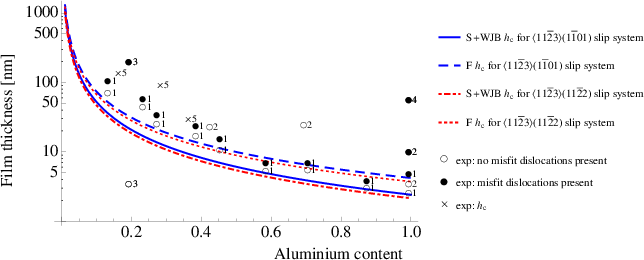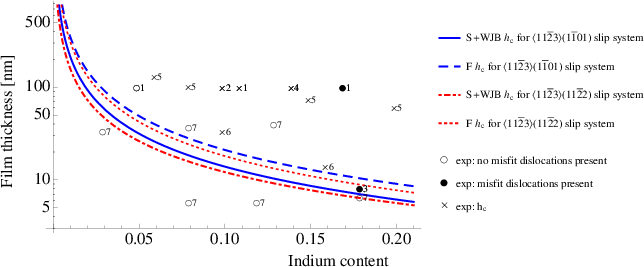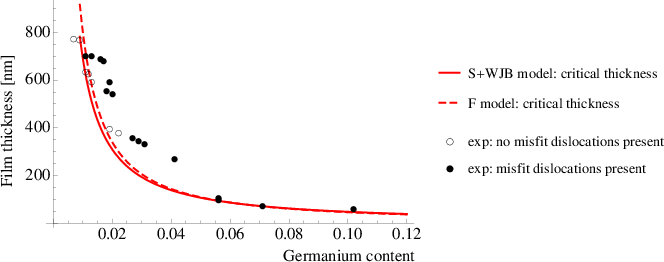4.6 Comparison between theoretical and experimental critical thicknesses
After illustrating the differences among various treatments of dislocation energy and their
impact on the equilibrium critical thickness , the Freund and Steeds+Willis et al. models,
including the dislocation core energies estimated in Section 3.6, are used to calculate the
equilibrium critical thickness as a function of composition, x, for the three different alloys.
The two models, Freund and Steeds+Willis et al., are chosen as they are based on opposite
hypotheses (see Table 4.1).
The 1∕3⟨1123⟩{1101} and 1∕3⟨1123⟩{1122} slip systems for AlxGa1-xN film on GaN
substrate and InxGa1-xN film on GaN substrate, and the 60∘ misfit dislocation with
the ⟨110⟩{111} slip system for Si1-xGex film on Si substrate are considered. The
calculated critical thickness results obtained from the Freund and Steeds+Willis
et al. models are compared with experimental observations and data available
in literature (Figures 4.14, 4.15, and 4.16). The difference between the Freund
and Steeds+Willis et al. results is small, with the Steeds+Willis et al. model
yielding lower values as compared to F. In all cases the experimental data are
close to the theoretical curves, suggesting that the experimental critical thickness
values were obtained from epitaxial depositions close to the thermodynamical
equilibrium.
Regarding the AlxGa1-xN/GaN and InxGa1-xN/GaN systems, the Steeds+Willis et al.
model provides a more severe condition for the onset of the misfit dislocation at the
interface than the Freund model. It is important to realize that the critical thickness
reported here is the so-called equilibrium critical thickness . That means that it
corresponds to the configuration where it for the first time becomes energetically
favorable to relieve the misfit strain by introducing misfit dislocations. However, any
mechanism for the creation of the misfit dislocations, which may require certain extra
activation energy, is not considered in the model. Similarly, parameters influencing the
kinetics of the epitaxial deposition, such as temperature and deposition rate, are also
not considered by the equilibrium critical thickness models. Finally, the current
experimental techniques are unable to detect the exact onset of the appearance of misfit
dislocations. It therefore follows that no misfit dislocations are expected below the
predicted critical thickness values, however, the detection of misfit dislocations
may be (sometimes significantly) higher than the theoretical critical thickness.
A closer inspection of Figures 4.14-4.16 reveals that the here refined Steeds+Willis et al.
model fulfills this criterion (unlike the Freund model). Indeed for all the studied systems,
the misfit dislocations are always experimentally detected above the critical thickness values
predicted by the model Steeds+Willis et al. unlike the values given by the Freund
model.


